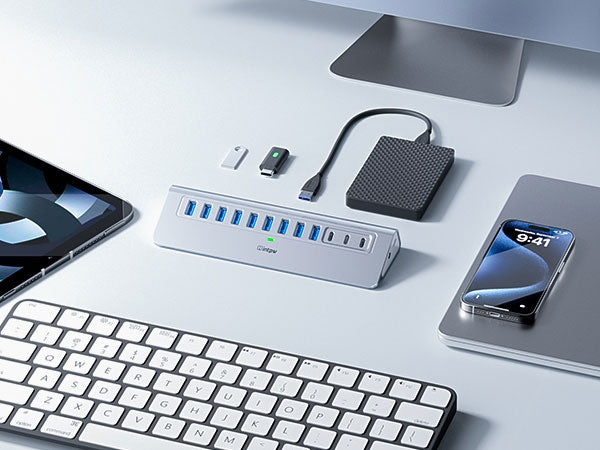
Thunderbolt 4 Backwards Compatible? Unlock the Secrets to Cables, Devices & More
, by USintpw, 10 min reading time

, by USintpw, 10 min reading time
Thunderbolt 4 is that zippy little wonder that hooks up your devices faster than you can say "where’s my cable?" But here’s the big question everyone’s asking: Can Thunderbolt 4 actually get along with older versions? Whether you’re wrestling with a Thunderbolt 3 Mac, clinging to a dusty Thunderbolt 2 setup, or drooling over shiny new Thunderbolt 5 gadgets, I’m here to break it all down—no tech babble, just straight talk.
Let’s figure out what connects, what flops, and how to tame this wild web of cables. Because honestly, don’t we all just want our tech to get along like old pals?
Here’s the happy news: Thunderbolt 4 is totally cool with Thunderbolt 3 stuff. Pop a Thunderbolt 3 drive into a Thunderbolt 4 port, and it’s like they’ve been buddies forever—works like a charm. Just don’t get too excited; you’re still stuck at Thunderbolt 3’s top speed, around 40Gbps.
Now, if you’re digging out Thunderbolt 1 or 2 gear from the back of your closet, things get a bit messier. You’ll need a trusty adapter—something like Apple’s Thunderbolt 3 to Thunderbolt 2 gizmo—to make them talk. Even then, it’s less of a high-five and more of a lukewarm handshake; don’t expect it to run at full throttle.

Here’s the scoop: Thunderbolt cables are mostly friendly across versions since they all use that familiar USB-C shape. A Thunderbolt 4 cable can handle Thunderbolt 3 devices, no sweat. Going the other way? A Thunderbolt 3 cable with Thunderbolt 4 gear works too, but it’s like putting a speed limiter on a racecar—performance takes a hit.
For the best results, grab a Thunderbolt 4 cable. It’s the future-proof pick that won’t leave you cursing at a sluggish connection.
Thunderbolt 3 cables are the dependable middle child—compatible with Thunderbolt 4 peripherals and most Thunderbolt 5 devices too. On a Mac or PC, they’ll connect just fine, but don’t expect Thunderbolt 4’s fancy perks (like dual 4K displays) or Thunderbolt 5’s rumored warp-speed potential.
Real-world tip: I’ve plugged a Thunderbolt 3 cable into my Thunderbolt 4 MacBook, and it’s solid for basic tasks. Just don’t ask it to juggle multiple high-res monitors—it’ll pout and underdeliver.
Thunderbolt 3 was the cool kid with 40Gbps speeds and solid video output. Thunderbolt 4, though? It’s the overachiever sibling—same speed but with stricter standards. Think better hub support, dual 4K monitors (or one 8K!), and up to 100W power delivery.
The catch? Thunderbolt 4 demands certified cables and devices to flex its full muscle. Thunderbolt 3 gear works with it, but it’s like inviting a casual runner to a marathon—functional, not phenomenal.

Thunderbolt 4 devices are picky about their dance partners. With a Thunderbolt 3 host (like a 2020 MacBook Pro), they’ll connect, but you might miss out on extras like daisy-chaining or peak performance. It’s not a total bust—just a bit of a compromise.
Thunderbolt 1 or 2 hosts? That’s a nostalgia trip too far. You’ll need an adapter, and even then, compatibility’s shaky. I tried hooking a Thunderbolt 4 dock to my old Thunderbolt 2 iMac with an adapter—it recognized it, but the speed was glacial. Proceed with caution!
Daisy chaining—linking devices in a chain—is a Thunderbolt superpower. Thunderbolt 4 keeps this alive and well, supporting up to six devices in a row. Mix in Thunderbolt 3 gear? Totally doable, but the chain’s only as strong as its weakest link.
Pro tip: If you’re daisy-chaining a Thunderbolt 3 monitor with a Thunderbolt 4 hub, it works—but don’t expect Thunderbolt 4-level magic across the board.
Got a Thunderbolt 3 Mac (say, a 2019 MacBook Air)? Thunderbolt 4 drives and docks will plug in and hum along happily. I’ve tested this with a Thunderbolt 4 dock on my Thunderbolt 3 MacBook—it’s seamless for data transfers and charging.
The downside? You won’t unlock Thunderbolt 4’s full dazzle, like supporting two 4K displays at once. It’s like driving a sports car in city traffic—still cool, just not at its peak.

Windows PCs with Thunderbolt 3 ports (think Dell XPS or HP Spectre) handle Thunderbolt 4 drives and docks like champs. Plug them in, and you’re good for fast data transfers and power delivery. I’ve used a Thunderbolt 4 dock with my Thunderbolt 3 Lenovo, and it’s rock-solid.
But—yep, there’s a but—some PCs might need a firmware tweak for full compatibility. Check your manufacturer’s specs to avoid any “why isn’t this working?” meltdowns.
Thunderbolt 4 cables are the Swiss Army knives of connectivity. They work with Thunderbolt 3 peripherals (drives, hubs, you name it) and should handle Thunderbolt 5 gear when it hits the scene. Macs and PCs? No problem—universal USB-C love keeps things simple.
Word of advice: If you’re eyeing Thunderbolt 5 devices down the road, a Thunderbolt 4 cable is a safe bet to keep in your drawer.
Thunderbolt 5 is still the new kid on the block as of March 2025, but early buzz suggests its cables will play nice with Thunderbolt 3 and 4 peripherals. Same USB-C connector, so physically, it’s a match. Macs and PCs should cooperate too.
The kicker? Using a Thunderbolt 5 cable with older gear won’t unlock its rumored 80Gbps speeds—it’ll throttle down to match the device. Still, it’s a cable worth snagging for future-proofing.

Thunderbolt 5 devices are forward-thinking, but they don’t forget their roots. With Thunderbolt 4 hosts, they’ll work like a charm, just at Thunderbolt 4’s pace. Thunderbolt 3 hosts? Expect compatibility, though with some features dialed back.
Thunderbolt 1 or 2 hosts? You’re pushing it. Adapters might get you connected, but it’s like pairing a rocket with a bicycle—don’t expect much lift-off.
Thunderbolt 5 drives and docks should slide into Thunderbolt 3 and 4 Macs without a fuss. On a Thunderbolt 4 Mac, you’ll get top-tier performance (up to Thunderbolt 4’s limits). Thunderbolt 3 Macs? They’ll handle it, but don’t expect Thunderbolt 5’s full horsepower.
I’d love to test this myself once Thunderbolt 5 gear lands—stay tuned for real-world vibes!
Windows PCs with Thunderbolt 3 or 4 ports will welcome Thunderbolt 5 drives and docks with open arms. Thunderbolt 4 PCs get the best deal—maxing out at 40Gbps. Thunderbolt 3 PCs? Solid, but you’ll miss out on Thunderbolt 5’s next-level tricks.
Check your PC’s Thunderbolt certification—some budget models skimp on support, and that’s a buzzkill.

Nope, you don’t need a Thunderbolt 4 cable for Thunderbolt 4 devices—a Thunderbolt 3 cable will do in a pinch. But here’s the rub: Thunderbolt 4 cables are built tougher, certified for peak performance (like 40Gbps at longer lengths).
I’ve swapped cables mid-project, and the Thunderbolt 4 one just feels more reliable. Worth the upgrade? You bet.
Absolutely. Pair a Thunderbolt 3 dock with a Thunderbolt 4 Mac or PC, and it’s a go—data flows, screens light up. Same deal with Thunderbolt 2 gear (via adapter) on a Thunderbolt 5 rig.
The trade-off? You’re stuck at the older device’s speed. It’s like using a flip phone with 5G—it works, but don’t expect lightning-fast texts.
Flip the script, and it’s trickier. A Thunderbolt 4 dock on a Thunderbolt 3 Mac or PC usually works, but some features (like extra monitor support) might ghost you. Thunderbolt 5 on Thunderbolt 3? Expect a step-down in oomph.
I’ve seen this in action—a Thunderbolt 4 hub on my Thunderbolt 3 PC ran fine but wouldn’t power dual displays. Frustrating? Yep. Fixable? Sometimes—just check compatibility first.

· Macs: Apple’s all-in on Thunderbolt. M1/M2/M3 Macs rock Thunderbolt 4; older Intel ones stick to Thunderbolt 3 or 2. Check your model—Apple’s support page is your friend.
· Intel PCs: Most modern Intel rigs (11th Gen and up) support Thunderbolt 4. Older ones? Thunderbolt 3, if you’re lucky.
· AMD: AMD’s catching up—some Ryzen 7040 laptops offer Thunderbolt 4, but it’s hit-or-miss. Verify with your manufacturer.
· Intel Mobile: Think ultrabooks—Thunderbolt 4 is standard on newer models, Thunderbolt 3 on older ones.
Thunderbolt 4’s backwards compatibility is a lifesaver for mixing old and new tech—just don’t expect perfection. Thunderbolt 3 gear fits right in, Thunderbolt 1 and 2 need a little TLC (and adapters), and Thunderbolt 5 looms as the next big thing. Cables? Stick with the latest for peace of mind.
Next time you’re plugging in, double-check your setup. It’s not just about connection—it’s about keeping the sparks flying at full potential.

Subscribe to our emails